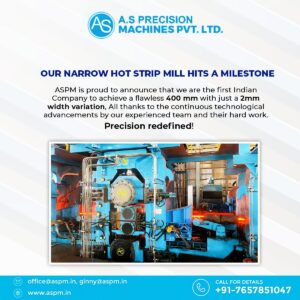Rolling Mill Equipment
Mill Stand
ASPM manufactures Mill stands which have rigid structure and thus are reliable. We Manufacture mill stands which have quick roll change capabilities and are have fully automatic operations to produce bars, wire rod, angles, channels, and universal beams.
The conventional mill stands consists of housing and cap assembly wherein the rolls rotate in bearings-fiber/anti friction bearings, housed in chocks which move up and down in housings fitted with liners on the inside. The roll gap is adjusted through screw down mechanism operated through worm & worm gearboxes mounted on the top of the housing cap.The rolls are powered and driven by electric motors through system of drives and spindles.
In each stand the housing and cap assemblies are connected through fabricated members both on the top and bottom side which hold them together and work as one single entity, taking all rolling loads through chocks, screw down system. Our mill stands are engineered based on balanced housing design that give minimum deflection under rolling loads.
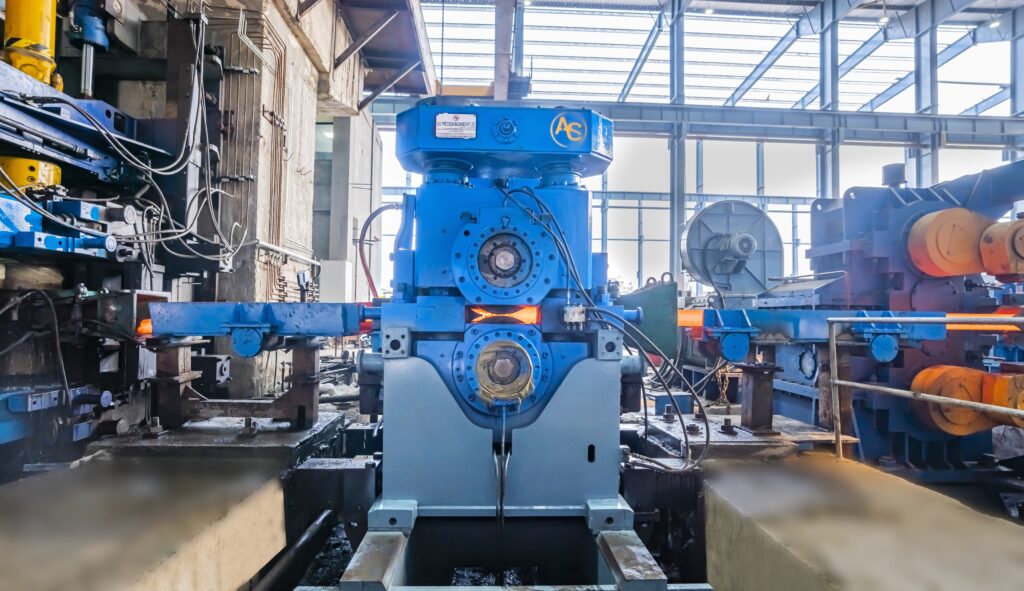
Housingless Stand
These housing less stands, as the name suggest do not have housings and caps, but the chocks carrying the roll assemblies are connected through four (4) housing screws mounted with worm wheels and worm which move either manually or through motor for roll gap adjustment.
The unique feature of the housingless mill stand is that the entire rolling load is shared by all the four pressure screws. The bearing life is enhanced as the rolling load is carried over a larger arc of contact in the chocks.
These housingless stands consist of short stress path and hence the mill module is high and helps in reducing the product size deviations over the stock length as also small deviations in temperature of stock do not adversely affect the product tolerances. We offer a combination of horizontal & vertical housingless stands in order to give sequential pass reduction without twisting the material and hence little chances of mill cobble (mis roll) is ensured. The mill stands are provided with axial movement feature by which a fixed pass line is achieved by shifting to new roll grooves in line with other continuous stands which are also on the same pass line.
FEATURES
» Robust, short stress path mill design
» High mill modulus (Load/Deflection) ensuring close product tolerances
» Fixed pass line
» Roll gap is monitored through encoder on the screw down system.
» Long bearing life as larger arc of contact is ensured for taking rolling load.
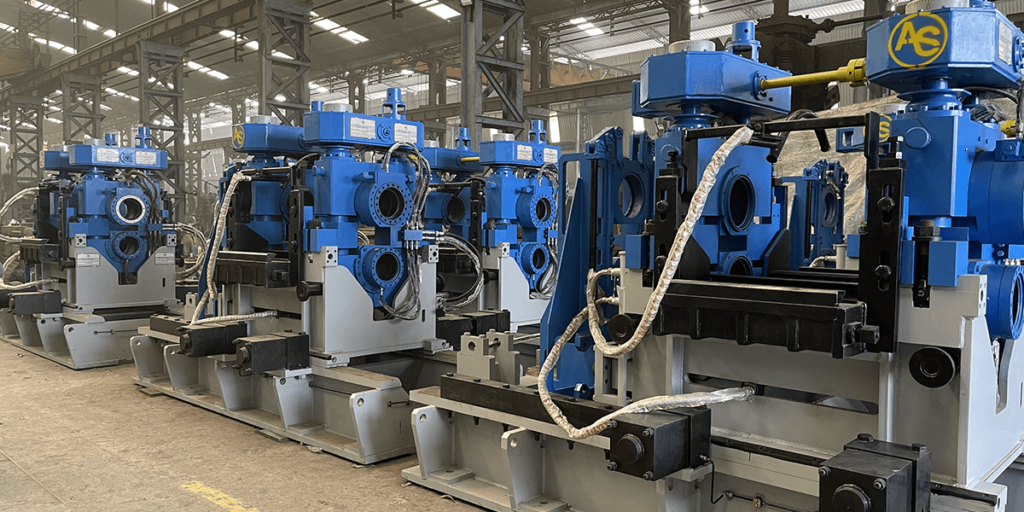
Pre-Stress Stand
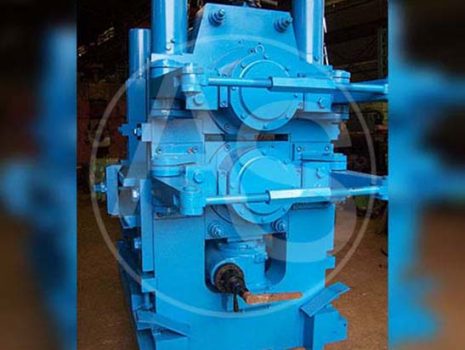
The mill stand is similar to Conventional mill stand but the mill is pre-stressed with the help of hydraulic four nuts that pre-stresses the roll loading system such that the mill is preloaded to the maximum roll separating force during rolling time. When the stock passes under the rolls there is practically no further deflection of the mill stand under rolling load.
Convertible Stand
The entire mill stand can be configured in horizontal or vertical configuration with the help of a frame pivoted to a rotating shaft which can be rotated through hydraulic cylinders.
Cantilever Stand
The cantilever stands are basically designed like a block mill and can be configured to horizontal or vertical position as per design requirement. The rolls are mounted on sleeve bearings so that high mill speeds can be achieved to produce wire rod 5.5mm to 8mm. Here the rolls are relatively small discs with width available for one or two passes, mounted on the cantilever shafts. The roll material is very hard and often made of tungsten carbide.
4Hi Stand
The mill as the name suggests consists of two back up rolls and two work rolls housed in the same housing. These are very much in vogue for the flat and strip mills. The work rolls bite the material and the rolling load is transferred to the larger back up rolls with high capacity bearings. The work rolls being small in diameter have small area of compression and hence the rolling load is less. However here the bite angle limitations have to be seen otherwise the material may start slipping and may not enter the roll bite.
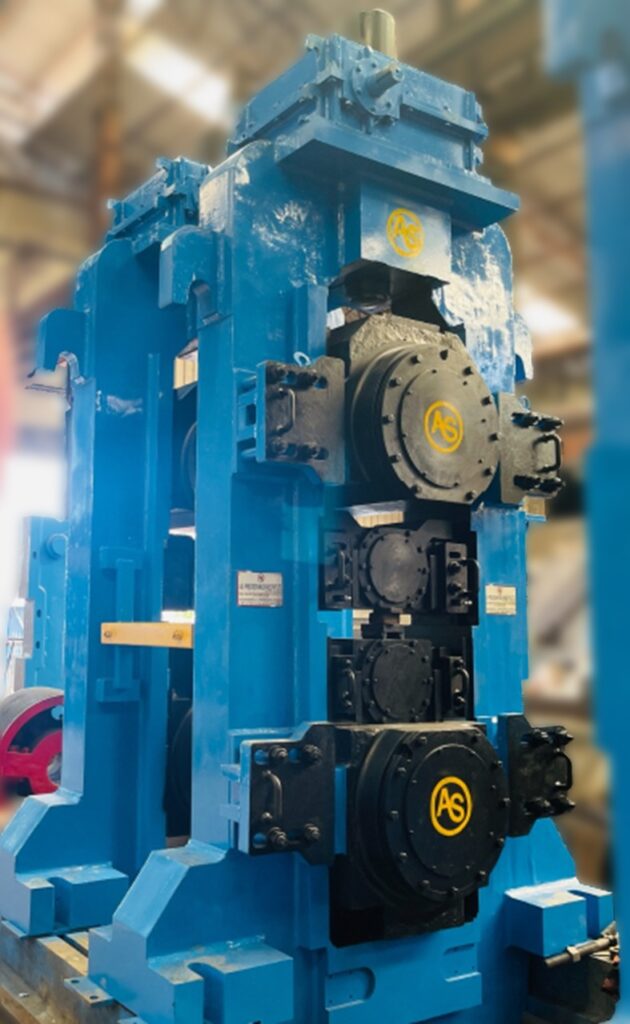
Gear Box Cum Pinion Stand
Single Stage | Double Stage | Multi Stage & Bevel Helical Gears
Applications:
- Reduction Gear Boxes.
- Reduction Cum Pinion Gear Boxes for mill Stands.
- Gear Boxes for Shear and Saws.
- Gear Boxes for Cooling beds and other auxiliary equipment like material handling equipment.
The gears are manufactured from case hardening steels like
EN353; Din 20 MnCr5 (1.7147), 17CrNiMo6(1.6587), 18 CrNi Mo7-6; SAE 8620. Case hardness 60+-2 HRC and shafts from En 9/EN 19 Steels for long life and trouble free service.
Gear Boxes & Pinion
We manufacture high precision and robust gearboxes to provide drive to the rolling mills. The gearboxes which consist of fabricated frames accurately machined housing the gear internals which are supported on antifriction bearings. The gears are lubricated by appropriate gear oil for long life and efficiency. The gear materials are of two types i.e. Volume hardened and case hardened gears as per the requirement of the customer.
Reduction Gear Boxes
Here the reduction gear boxes combine with two or three high pinion stands as one single input and 2/3 outputs for directly connecting to the mill stand rolls through mill spindles.These gear boxes are much in vogue these days as they occupy less space and are economical than having two separate reduction gear box and pinion stand.The material of the gears are normally 18CrNiMo-7/6 and are case carburizes and profile ground to give a long life.
Speed Increasers
A Speed Increaser gear box is generally installed in Bar Mill in between intermediate Mill Stands to increase the output speed of the rolled product. . These are Steel Fabricated gear boxes.
The Gears & Pinions are forged 18CrNiMob-7/EN353/ 20MnCr5 steel case hardened and progile ground to 60±2 HRC, shrunk fitted on En-9/ En19 forged steel shafts.The gears and pinions will conform to DIN 3 / 4 Standard. Single helical teeth are hardened and Profile Ground on CNC Gear grinder machines to give high contact ratio and low noise or vibrations.
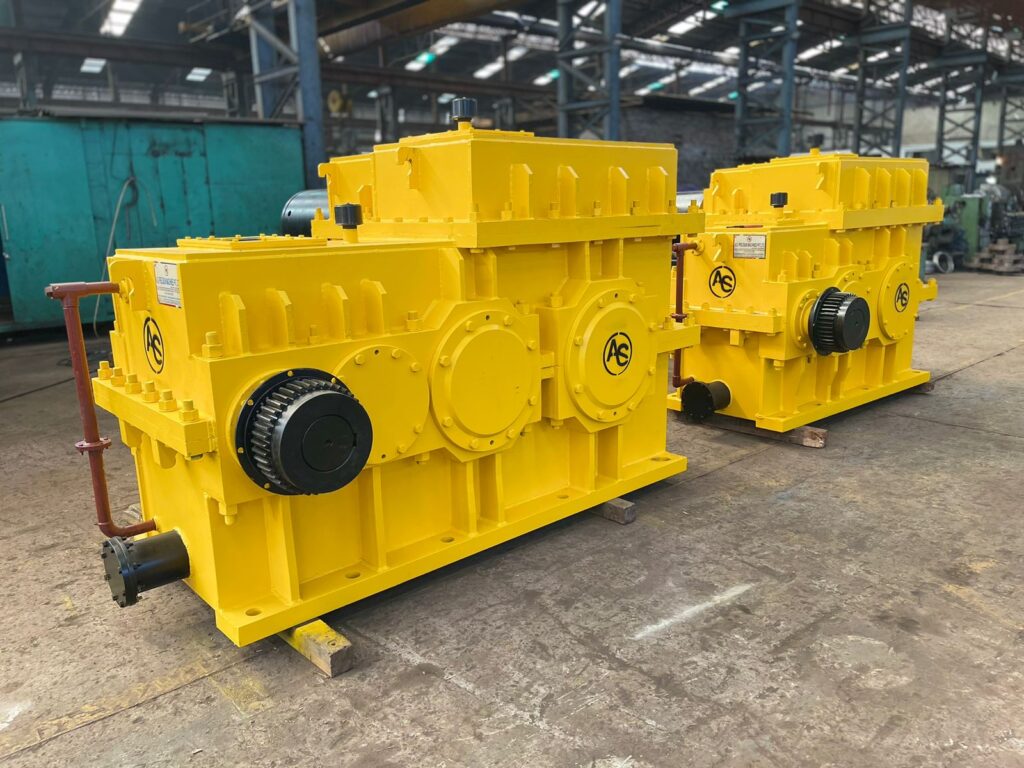
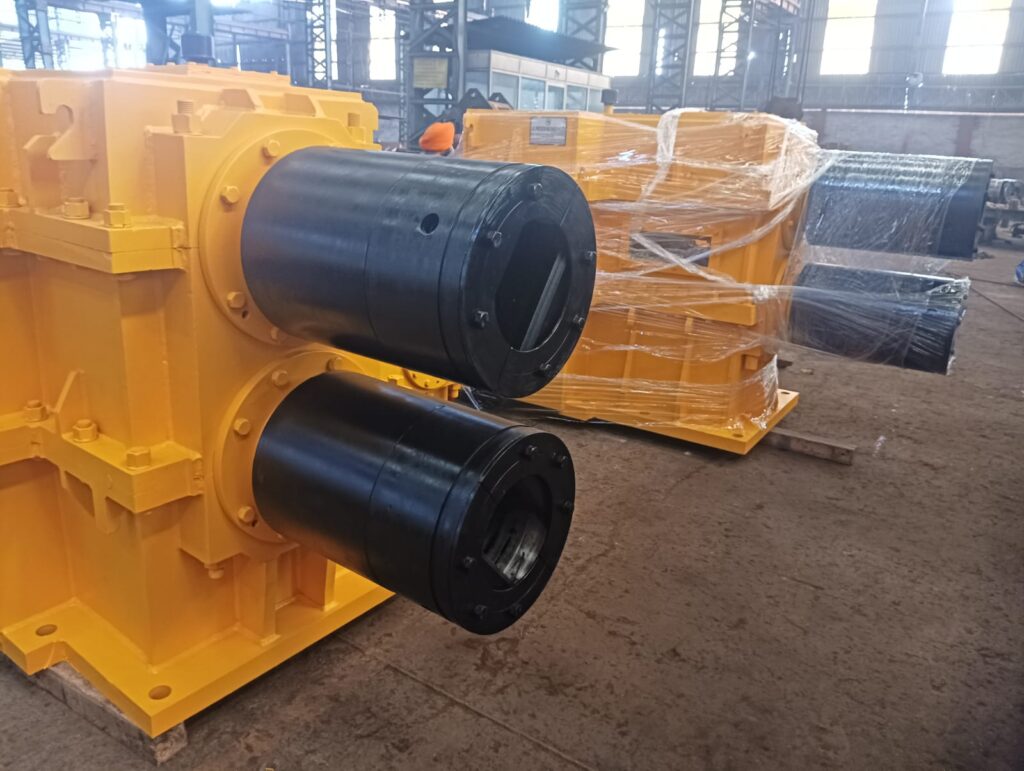

Shear & Saws
ASPM is a leading manufacturer & supplier of shears and saws for Rolling mills industry in India . We have wide range of shears and saws which are sturdy in construction and have higher efficiency. We have wide range of the shears and Saws which suits best to the clients requirement Customized solutions can also be provided that fits well into the client’s unique business requirements.
Rotary Shear Crop & Cobble Shear
- These are manufactured in various sizes with centers ranging from 500 mm to 850 mm depending on the sizes of sections to be cut.
- The gears are made of case hardened steels and the shafts are forged from C45 steels. Depending on location they can cut different sections at speeds in line with the speed of the bars.They cut the material on the fly.
- Select fabricated housing
- Anti friction bearings
- Entry guide – Fixed
- Exit guide- Pneumatically operated, bottom collapsible type for crop disposal.
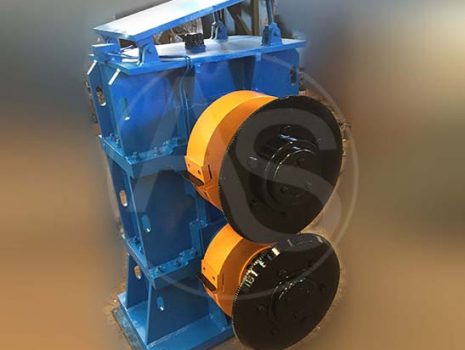
Crank Type Flying Shear
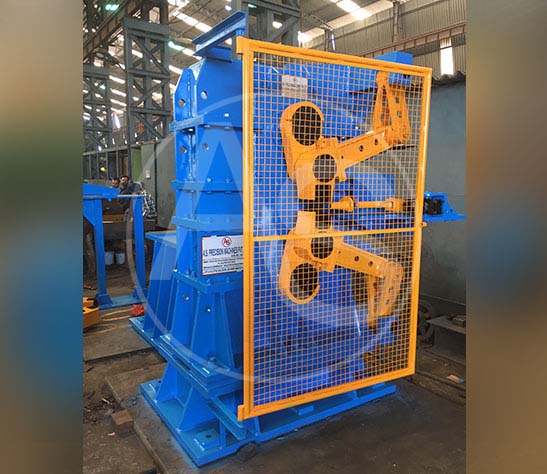
Crank type flying shears are used for cutting finished stock of 10 to 70 mm size. While in Crank mode, the cranks operate and ensure a clean cut on the both the ends and will not require de-burring of the ends. These are also start & stop type and powered with appropriately powered variable speed motors to cater to different finish line speeds of the product. In flying mode the cranks do not operate and the cropping of the ends is done at higher speed for small sections. The bars are cut to cooling bed lengths as per requirement.
Technical Features
- Sizes to be cut(flying mode) Ø8mm- Ø16mm(Max). TMT
- Sizes to be cut (without crank) Ø8mm- Ø16mm(Max). TMT Speed 24-14m/s
- Sizes to be cut (with crank) Ø16 mm- Ø32mm TMT, Speed 7-3 m/s
- Bar Speed : 24 m/s per (max) to 3m/s
- Blade Center: 1020mm
Continuous Shear
Range 8mm to 16mm TMT bar.
FUNCTION
To cut set length of TMT bar being rolled above 20m/s at a minimum temperature of 550 deg C
HIGHLIGTS
» The casing is vertically split to take the separating force during the thermally seconds when the cut is executed on the casing profiles instead of parting bolts.
» The blade holder is fitted with double cone torque couplings as a safeguard against the accidental overload.
» The Case hardening steel gears are case carburized hardened & profile ground designed for minimum backlash and long life.
» Entry diverter with servo motor & pneumatic cylinder.
» Entry two line guide provided.
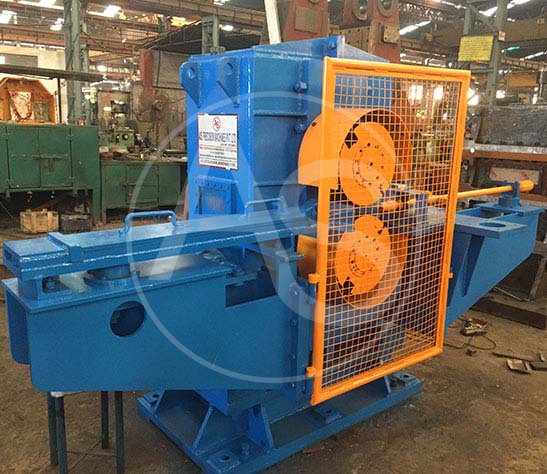
Cold Shear
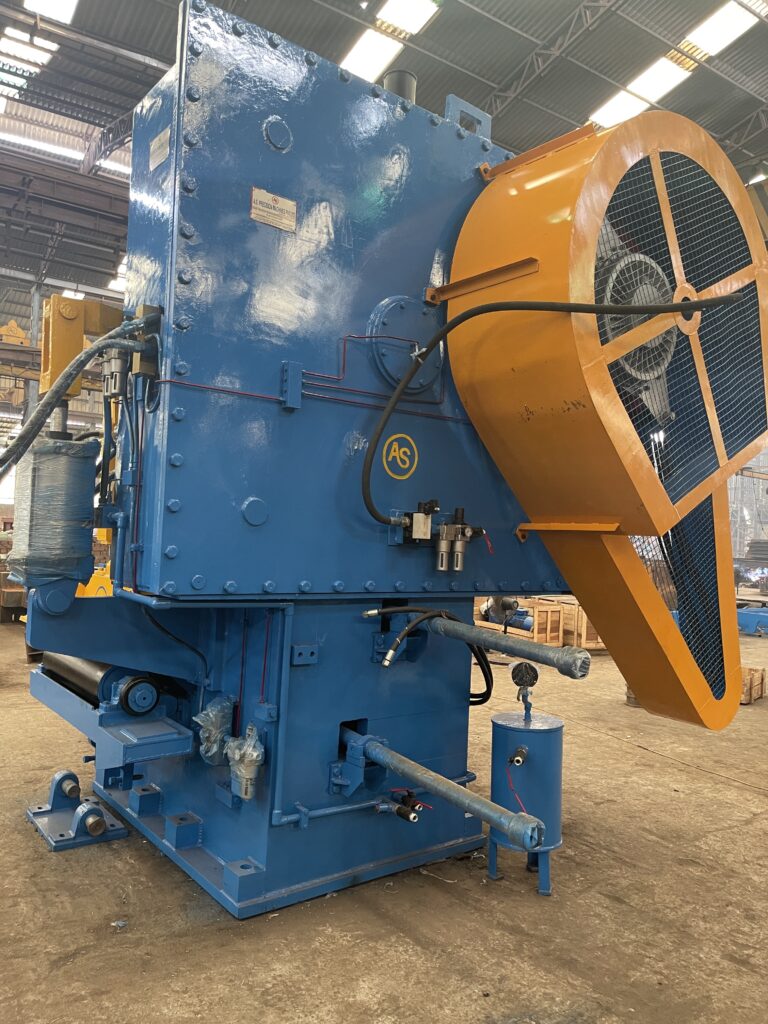
Prime function of Cold Shear is to cut the bars in layers to commercial lengths. The cold shear is open on one side to cold cut of the bars in layers. The frame is welded steel construction and houses gears which operate the eccentric shaft to make cut on the bars. Welded steel housing is perfectly oil tight. We use heat treated and forged alloy steel gears. Shaft assemblies are mounted on bearings. The design is specially made for heavy-duty operation, the machine parts are designed to operate under heavy forces impinged during shearing of the sections arranged in layer as per width of the blades. Shearing is performed by a pair of knives one of which is fixed and the other mounted on a movable slide, which is every time started and stopped by an air operated brake cum clutch.
Cold shear is lubricated by an automatic lubricating system mounted on the shear itself. Sections normally range from 8 mm to 40 mm in diameter.
Billet Shear
ASPM manufactures Billet Shear to cut upto 300mm size billet in MS and alloy steel grade.The billet shear consist of fixed blade at the bottom and a moving blade through the guides to cut billets as per requirement.
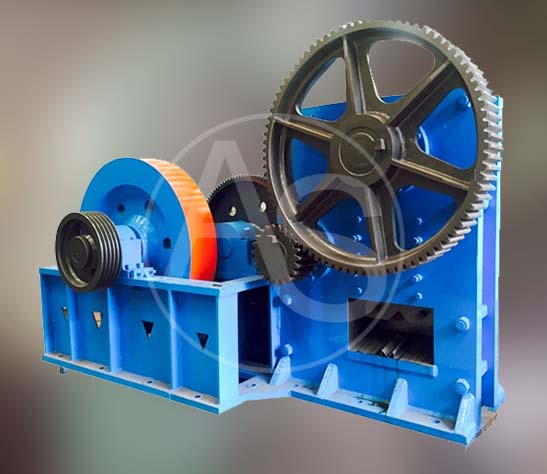
Hot Saw
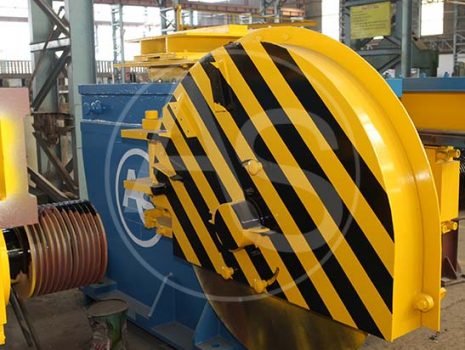
Cold Saw
The cold saws in design are similar to hot saw but instead of chip cutting as in the case of hot saw the cold saw cuts the material through friction melting of the material by cold saw blade.The cold saw blade instead of having teeth on the periphery has serrations which provide friction cutting of the material at higher speeds than the hot saw.The feed speed is also lower as compared to hot saw feed speed.
Cooling Bed Manufacturer
ASPM provides Cooling bed that are compact in design and the best in quality. We provide all types of cooling beds as per your mill requirement which can cool the material and cross transfer towards the discharge end. ASPM manufactures Rolling mill Cooling Beds in-house and thus assures the best of quality, these have excellent corrosion resistance which leads to greater durability and sturdy structure.
These are used to cool the material transfer the material towards the discharge end.These are specifically designed for the minimum and maximum size of the bars being rolled into the plant. These Cooling beds provide adjust ability to the size of the bars at the appropriate cooling rate and minimized distortion. The cooling beds ensure equipment quality and higher performance levels.
Rake Type
Turn Over Type
The first part of the system is composed of cast grids, followed in the second part by toothed rakes. Moving rakes supported by beams placed on eccentrics provide transversal advance of bars. In the last toothed area of the rakes, aligning rollers actuated by gear motors make the bars advance against an end stopper so that these result perfectly aligned, ready to be discharged into the chain transfer. The rake drive is provided by means of motors with variable speed.
Turn Key Manufacture of Turn-over Cooling Bed inclusive of all Electricals, Drives and Motors.We undertake custom built design & engineering of Turnover Cooling Bed to optimize production & power capacities.
Fifth generation In-line Planetary Gear Boxes together with Variable Frequency Synchronous Drives fitted with BOP imparts flexibility to driving arrangement of the Cooling Bed.
Starter Web tool provided for drives to be taken online through Computer and necessary programming can be done, if required at a later date.
Fully automated men-less operations from loading till unloading of the bars from Cooling Bed. Necessary interlocking provided for its fail-safe operations & forewarn alarming through Beacon Lamp.Drive shafts and moving platform is balanced that results in power saving. Current drawn by main motors can be viewed through HMI placed on control desk.
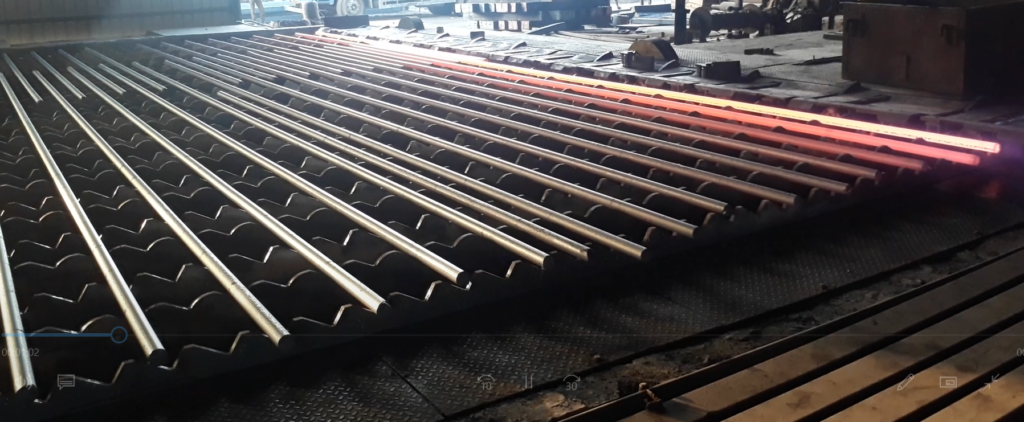
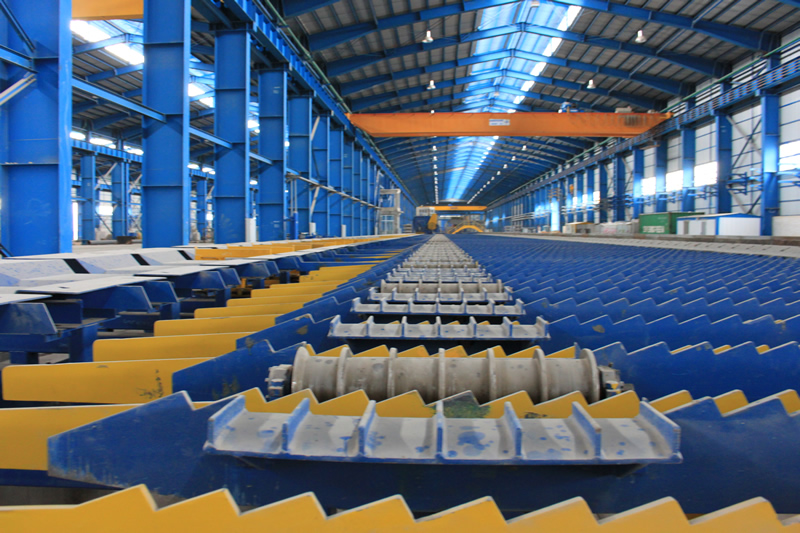
Quenching System
We offer best quality Quenching System/ TMT Box that are widely installed in steel rolling mills industry. Cooling Nozzles made of high quality stainless steel are placed in between stripper nozzles. TMT water strippers are also made of stainless steel. The nozzles and other tubes are mounted on a machined platform. The platform is covered with a hinged cover. The TMT box containing various system of nozzles and tubes for various sections is having wheels underneath which can be moved to align with the bar size to be quenched. We offer multiple injector type TMT system with high grade quenching boxes that provides consistency of yield strength, ability to cool bars accurately.The quenching box allows the multiple entry of fresh water at regular time duration that saves the time of quenching process.
The aim of the quenching system as offered by ASPM is to provide for Production of High Strength TMT rebars as per Grade Fe 415, Fe 500 & Fe 550 conforming to BIS 1786 or equivalent international standards. Carriages mounted on wheels allow traversing to align the suitable cooling elements to the mill line for quick change of rolling program.
To achieve controlled cooling of ribbed bars cooling nozzles and cooling tube lengths are set for each range of bar diameters, as per rolling speed. Each cooling element consists of one tubular external shell with water and compressed air nozzles, manometers and one set of special internal elements. Their special converging / diverging design with an optimized angle, assure the highest degree of heat exchange rate between cooling water and traversing bars. Different sizes of cooling elements are used to cover the range of products. A roller way with motorized rollers is provided when cooling elements are not used to make a bye pass of the product. Cooling elements and roller way are supported on steel frames fixed on the foundation.
The technology consists in intense cooling of the bars by violent water flow through the annular spaces in the cooling tubes that impinge on the moving bar thereby converting the outer surface into martensitic micro-structure whereas the core remains hot in ferritic micro-structure. During further progress in the tubes the outer ring of the bar recoups energy from the core and converts to tempered martensite and the core becomes pearlitic structure. This gives enhanced yield strength combined with high elongation properties to the rebar. This way by controlling water flow for a certain rolling campaign mechanical properties can be achieved as per BIS 1786 standard or other international standards for use in concrete buildings, bridges and other such structures.
Besides the above mechanical equipment, certain sensors and other instrumentation are required to regulate flow of water. Also a water complex having hot and cold water pumps besides cooling tank and cooling towers with feeding pipe line too are required. The pressurized cold water is fed to the TMT cooling box.
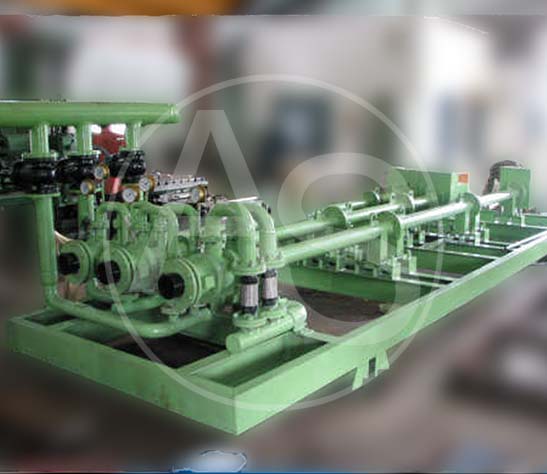
Twin Channel
Twin channel is used to collect the TMT bars exiting the Quenching boxes after being cropped by the Flying Shear. These channels comprise of CI central box and C-type CI channels, which are suspended from a longitudinal structural. The closed C-type channels ensure highest-level safety during the operation. This is an exceptional arrangement as the bar is carried in the close channel, minimizing the risk of accident. It is the most desirable feature in a high-speed rolling system.
When the material comes to a standstill position then the twin channel discharges the bars onto the bed below automatically. Twin channels are available for max 40mm bar sizes and the for stock speeds as high as 30 mps.
Twin Channel is an exceptionally well designed system and is extremely necessary as it carries the bar in a closed channel, minimizing the risk of accidents, especially while carrying out high speed rolling. It is designed in such a way as to work in conjunction with braking pinch rolls, minimizing the length of run-in. The operations are automated and are guided by the discharge of the rods from dividing shear. The maintenance cost is drastically reduced due to the innovative idea for cast iron center boxes.
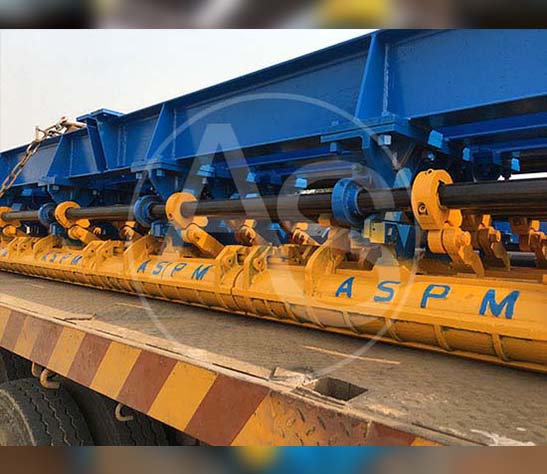
Pinch Roll & Tail Breaker
We are a leading manufacturer of Pinch rolls and Tail Breakers that is made from high-quality raw material and advanced technology. The pinch rolls are cantilevered and the top roll is raised or lowered pneumatically. The pinch rolls function is to drive the bar through dividing shear after it leaves the finishing stand. Also these are used one each for crop and cobble shears. The pinch rolls assemblies rotate in chocks housed in fabricated frames and are driven through D C Motors through gear box and the cardan shafts. The roll size varies from 250 mm to 550 mm depending upon the requirement of the mill.
We manufacture Cantilever and pneumatic type Pinch Roll & Tail Breaker up to 550 MM CRS. The Top roll is raised or lowered pneumatically with bottom roll is adjustable to pass-line. The Pinch roll housing has sturdy welded construction, which feature wear resistant surface with anti-friction bearing mounting support and the use of sensors that allows precision breaking up of the speed of hot bar material. The signal in case of breaking pinch roll is received from DC Motor of Dividing shear for actuation. There are two DC Motors driving each set of breaker pinch rolls. There is selector switch which guides the bar to one of the two channels. The tail breaker pinch roll reduces the bar speed so that it stops within the twin channel.
Pinch Roll Consists of two rolls to pull the material, when it has left the stand and pushed into the next stand, quenching box or the next processing equipment. The top roller can be approached or moved away by means of a pneumatic cylinder. The bottom roller is adjusted in height with a screw-down system to suit the rollers position to the bar dimension. The steel housing is perfectly oil-tight. Forced lubrication system for gears and bearings of pinch roll designed for connection with an out- side system under pressure. The pinch rolls get signal through HMD (Hot metal Detector) through PLC. The HMD placed ahead detects the front end and transmits signal.
Stand Quick Change Device
For the rapid and simultaneous change of the stands without using the crane, the stands are moved out of the stand bed plate onto a changing car by a hydraulic operated stand shifting system. The system can operate individually or with two simultaneously, depending on the production schedule. A stand change sledge is positioned at each stand and has the capacity to mount two stands set side by side. Old rolls are stripped off the chock assemblies, and these chock assemblies are inserted into the new rolls. These roll assemblies are then put in the mill stand to complete the roll change.
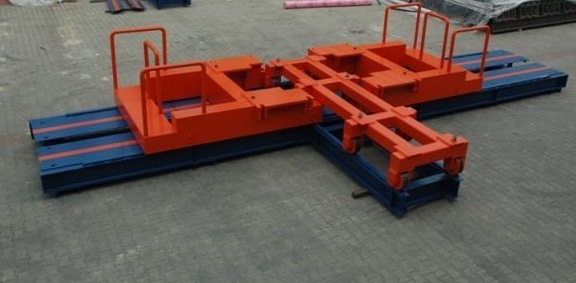
Material Handling
Chain Transfer
First Chain- Layer Transfer: Single section of driven chain modules, lift able type to transfer the cut bars.Chains are heavy-duty type and slide on steel guides. Each transfer section is driven by means of electric motors and gear reducers. The transmission shafts are mounted on roller bearings. Frame is made of steel section.
Manual grease lubrication used, the carriages, double sequence type, will discharge the bars from cold shear run out table to the second chain section. A chain lifting device lifts the chain, normally positioned under top of the cold shear run out rollers,above the roller table and transmits to the chain transfer #2.
Second Chain Transfer:
This chain transfer is located downstream the first chain transfer, its function is to feed the bar to the counting system with layers of bars.Chains are heavy-duty type and slide on steel guides. Each transfer section is driven by means of electric motors and gear reducers.The transmission shafts are mounted on roller bearings which in turn rest on the steel frames.
Third Chain Transfer Section
Located downstream the bar counting system, its function is to transfer counted bars to the bundle forming station. Chains are heavy-duty type and slide on steel guides. Each transfer section is driven by means of electric motors and gear reducers.
The transmission shafts are mounted on roller bearings, frame in steel section. All bearings and pivoting points are grease lubricated.
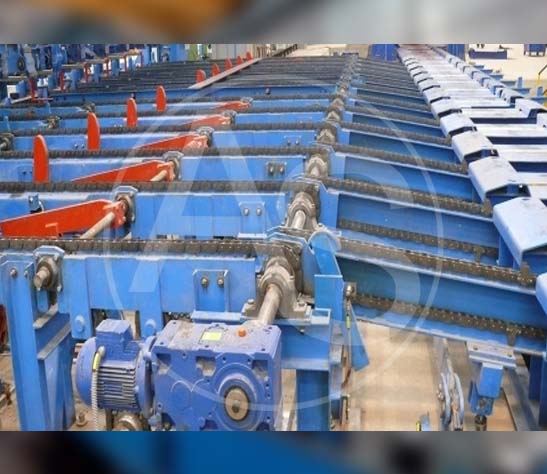
Bar Counter
Located aside the second chain transfer, its function is to automatically and accurately count the bars before bundle formation. Welded steel structure support the bar counting system. A chain moving at speed higher than the one of the chain transfer creates a gap between two sets of bars allowing bar counting through photocell and also through rotation of the counter. A set of separating fingers operating by pneumatic cylinders will separate the last bar counted from the counting screw. The separating fingers separate two sets of bars, one after the other, in cascade sequence.
Bundling Station
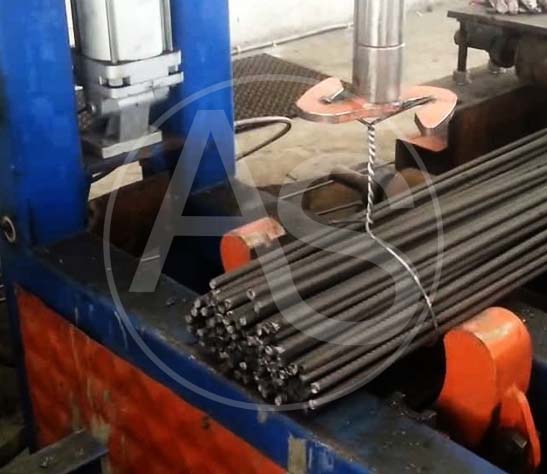
Welded steel structure. The counted bars from the bar counter are transferred to a collecting cradle for sub-bundle tying machines or for master tying machine. There are a total of 4 sub-bundle tying machines. The sub-bundles are transferred to the discharge roller table with the help of transfer arms until a full master bundle is obtained. A set of collecting arms will receive and contain bars. Manual grease lubrication of bearing.
Bar Collection Systems
High Speed Bar Collection System (Rotating Drum):
In case of higher capacity mills, the finishing speed of the bar is very high, the twin channel is replaced with a high-speed bar collection system, which we name as rotating drum; a drop wall system or a rotating twin channel, which can receive more than one finished bar concurrently.
Short Bar Collection System
Layers of bars are stopped over a roller table, a magnet stops the ends of full length bars, while the rolls extract the short bars from the layer. Short bars proceed on the roller table outside the chain conveyor, up to an end stopper. Scrap bars are collected in cradles for manual binding and removal. Roller in steel tube mounted on roller bearing support. Each roller is individually driven by means of gear motor. Frame in steel sections.
Roller Table
Roller Conveyor or Roller Tables are mostly used in section TMT Rolling mills. Instead, nowadays to reduce labor effort, everywhere(where possible) conveyor is used. It needs to transfer Ingot/Billet to change Furnace, then to feed ingot from Furnace to Roughing Mill and in cooling bed conveyor is utilized to transfer finish product to cut with the desired length of Shearing machine.
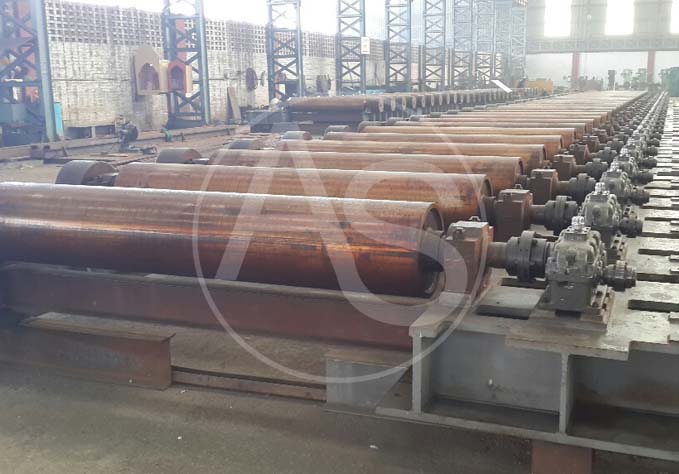
Gear Couplings
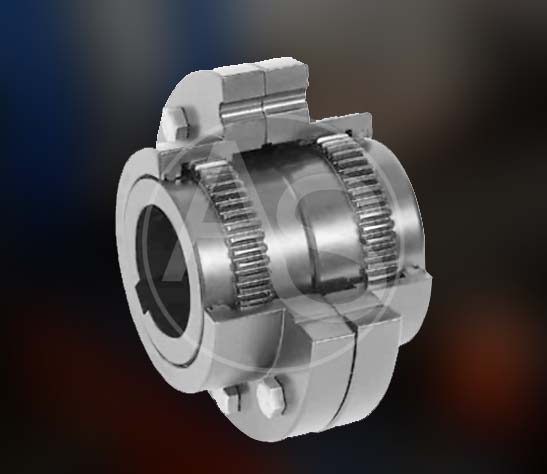
Our company provides supreme quality Gear Couplings which has application in different industries like steel industry, cement plant, sugar mill plant, metal industry. It primarily provides connection between two shafts, which are together, attending the purpose of transmitting power.
These gear coupling are rigid as well as flexible, which comprises of two hubs with an external gear and two outer sleeves with an internal gear. Our gear coupling is universal and is compatible for angular, offset and combined as well as large axial moments.
The Gear Coupling are of EN-8 and En-9 material which is Tested and Forged. These are Suitable for mal-alignment of Shafts up to limited angles and to transfer loads up to 3000 HP. They have teeth profile suitable for smooth running.
Coilers
ASPM manufacturers Coilers which have a wide range of applications, including heavyweight and large coils, our coilers help in Improvements in coiling capacity, coil shape and helps in the prevention of defects on coils. The coilers prevent the coils from sliding or falling and thus provide stable coil transportation.
The design is compact and rugged. The laying pipes are so configured to obtain the output coils of perfect shape. Bearings are protected heat radiations.
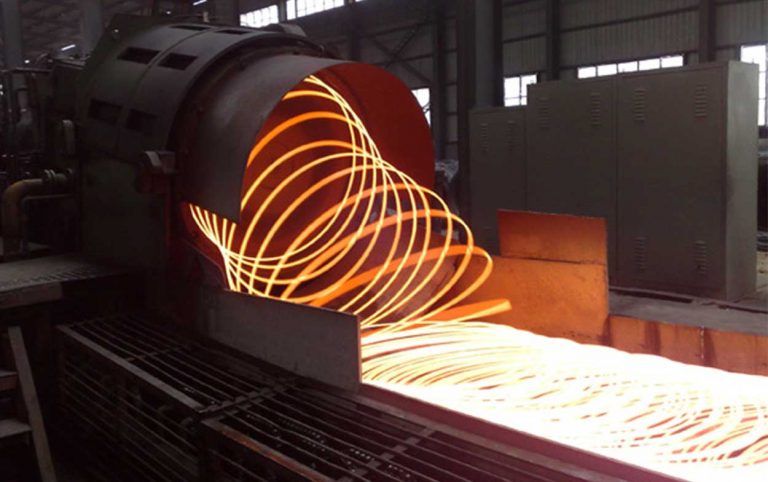
CNC Roll Turning Lathe & Branding Machine
Roll Turning Lathe
In today’s day and age the CNC Roll turning lathes replaces the manual lathes which is used by the steel plants for their Roll shops for pass cutting and machining of the Rolls. These CNC machines saves time, reduces labour, eradicates manual errors and minimizes the space required for turning operation in machining the rolls and thus lead to productivity enhancement and are available in various models suiting the need of the customer. These machines are the best economical solutions to improve the quality and productivity thus enhancing the profitability.
Branding Machine
ASPM provides CNC branding machines which has copper electrodes that are manufactured as per the customer’s brands that they need on their end product and are available for entire range like the rebar’s, Sections, Angles, Channels, Beams etc. Multilingual scripts can be embossed on the end products depending upon the customer’s area and most commonly used language. These machines are ideal for all grades of Casting Rolls and TC Roll Rings.

